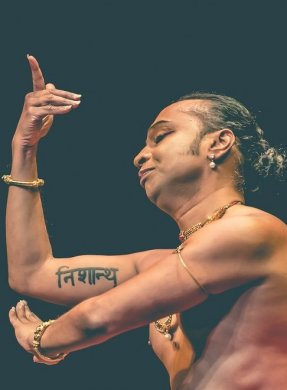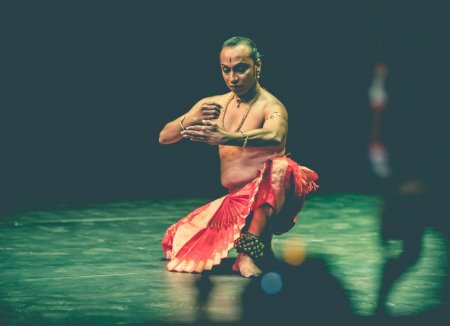
|   |

|   |
Carrying forward the tradition - Kate Macdonald e-mail: katetmacd@gmail.com Photos: Sivaruban Sivalingam January 10, 2023 A full moon floated auspiciously in the Ottawa night sky as I made my way to a special Bharatanatyam performance. And indeed, everything seemed to bode well on that December evening as I settled into my seat, felt the cumulative energy of the rasikas gathering, and fell into the expectant hush as the lighting heralded the beginning of what proved to be an exquisitely curated programme inspired by the Margam tradition.  The artiste, Jayadev Raju, is an Ottawa-based Bharatanatyam performer. Initiated into the art by the renowned Guru Dr. Padma Subrahmanyam in India, he subsequently trained with Gurus Dr. Kalarani Ramachandran and Delhi V. Krishnamoorthi. Jayadev moved to Canada from India in 1999, where he made his artistic debut as a performer in Winnipeg with Manohar Performing Arts of Canada. As a freelance Bharatanatyam artiste in Ottawa, Jayadev has participated in many arts and community events and festivals in the last 17 years. Jayadev continues training with Gurus Sheela Chandrashekar, Induvadana Balan Malli, and Guhendran Saravanapava. In conversation with the artiste, I learned that his passion for Bharatanatyam is coupled with a full-time career as a research scientist in the Federal Government. It is, he assured me, often a struggle to find a balance between the two. And yet, he has experienced moments of integration: science and art can be complementary entities. The objective, analytical approach of Jayadev’s scientific side informs his mastery of the highly codified and uncompromising precision demanded by Bharatanatyam. Another very real challenge for the artiste is that there are only 24 hours in a day! How, I wondered, can a full-time scientist find the requisite hours of practice needed to develop the stamina and style to perform? Jayadev: “I have been criticized for not presenting a full Margam programme, but it just isn’t possible within my current time restraints. Should I give up performing altogether because I can’t meet this requirement? No. I am a dancer. So, I came up with the idea of separating the component elements of a traditional Margam performance into 2 or 3 shorter performances. It is also easier for the audience to digest…” Jayadev’s vision took shape last year in a presentation that included pieces traditionally performed in the first half of a Margam; his December 8th presentation this year included pieces usually performed in the second half of the programme. After invoking the blessings of Lord Ganesha, Jayadev’s 2022 Margam treated the rasikas to six meticulously prepared pieces. Guru Adyar Lakshman created the solkattu and choreography for Nandi Chol, an invocatory piece set to music by Muthuswami Dikshitar which opened the programme (Vasantha ragam, adi talam). Nandi the bull, Lord Shiva’s vahana or vehicle, enters using the four main drum strokes or chol, celebrating the attributes of his Lord. Jayadev’s rhythmic precision enveloped the rasikas in whirling images of Lord Shiva, who, as Nataraja, Lord of the Dance, cast blessings over the stage space. Jayadev selected the next five musical compositions with music arranged by B.V. Balasai, an acclaimed Carnatic flautist and musician based in Chennai. Hailing from a family of musicians, Balasai is known for his modern and versatile approach to adapting traditional Carnatic music for theatre, dance, and cinema. Jayadev and Balasai have a collaboration spanning 20 years through their work with Manohar Performing Arts of Canada.  Jayadev then introduced Rama, the central character of the Ramayana, in Abhirama, a piece inspired by this beloved epic and choreographed by Guru Kalarani Ramachandran. Lord Rama embodies the highest human values to which we can all aspire. This piece depicts three scenes from Lord Rama’s life: the liberation of the monkey king Sugriva from his tyrannical brother Vali; the liberation of the innocent Ahalya from the curse of a husband suspecting her of infidelity; and the emancipation of Shabari, a frail elder and ardent devotee of Lord Rama. With text in Tamil and Sanskrit, this piece is set to music by K. Narayanaswamy Aiyyar, an early 20th century composer. Jayadev effectively portrayed the compassionate actions of Lord Rama, infusing the evening’s entertainment with the hope that, with right effort, we can create meaningful transformation in the world. In the third piece of the evening, Jayadev portrayed the 18th century saint Thyagaraja. Nadachi nadachi is a krithi or devotional song in Telegu that invites us to perceive Lord Rama and his beloved Sita as divinities who reside within the temple of our very heart. Jayadev’s nuanced portrayal of bhakti rasa evoked the same devotional love within the heart of this rasika. This piece was adapted from the 1999 thematic dance production Alchemyth by Manohar Performing Arts of Canada (Karaharapriya ragam, adi talam). The fourth item on the night’s programme was a padam: Yaro Ivar Yaro (Kanada ragam, adi talam). Shringara rasa, a cornerstone of the Margam presentation, was exemplified in the emotional expression of this piece. This musical allegory of romantic love is taken from Arunachala Kavi’s Rama Natakam and choreographed by Guhendran Saravanapava. Jayadev perfectly captured Lord Rama pausing in astonishment at the beauty of Sita whom he perceives through the breezy curtains of her verandah. Ultimately Rama realizes that he is Lord Vishnu and she is none other than Lakshmi Devi residing in his heart as he reclines on his serpent bed in the milky ocean. Thillana, traditionally the penultimate item in a Margam, is a beautiful and fast-paced choreographic composition. The Tamil verse used for this piece celebrates the omnipresent grace of the Goddess of the three worlds. Jayadev’s interpretation channeled that grace into the intricate rhythmic patterns that characterize nritta or pure dance, and demonstrated purity of line, stamina, and agility. The choreography for this Thillana was created by Induvadana Balan Malli (Hamsanandi ragam, adi talam).  The programme finale left the audience to ponder the eight manifestations of righteous human values, each offered as a lotus flower in Ashtapushpam. The Sanskrit hymn upon which this choreography by Guru Kalarani Ramachandran is based (Malika ragam, adi talam), drew us back some 3,000 years to the Rig Veda. Non-violence, control of the senses, love and compassion to all living beings, forgiveness and inclusivity, knowledge and intellect, austerity and contemplative meditation, peace, truth, these eternal truths hold the key to our spiritual emancipation and indeed to our very survival on this planet. The rasikas included dignitaries from the High Commission of India, from the Great India Festival, and from the Bharatanatyam and dance fraternity. The National Arts Centre Dance’s executive producer Cathy Levy expressed appreciation of the performance. There seemed to be a deep sense of connection as we mingled after this well-attended live performance. I slipped back out into the cool moonlit evening transformed, with much to ponder, buoyed by the inspiring beauty of the Bharatanatyam tradition and Jayadev Raju’s passion to creatively carry it forward.  Kate Macdonald is a retired English teacher who discovered the joy of Bharatanatyam 2 years ago at age 62. Her Guru, Supratim Talukder of Kolkata, believes that learning can happen at any age. Jayadev Raju has warmly welcomed her into the Bharatanatyam community in Ottawa, where this exquisite art is flourishing. |